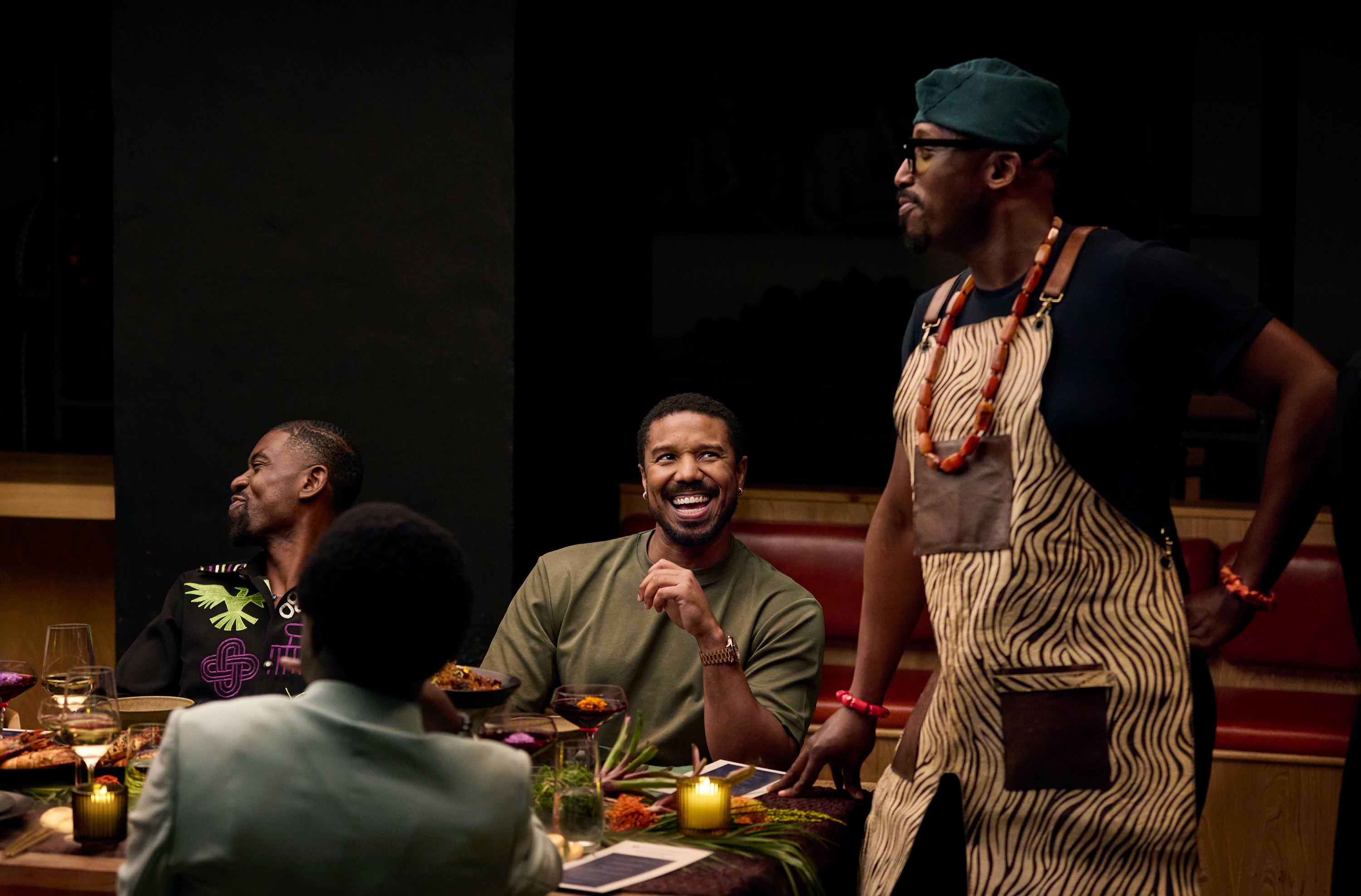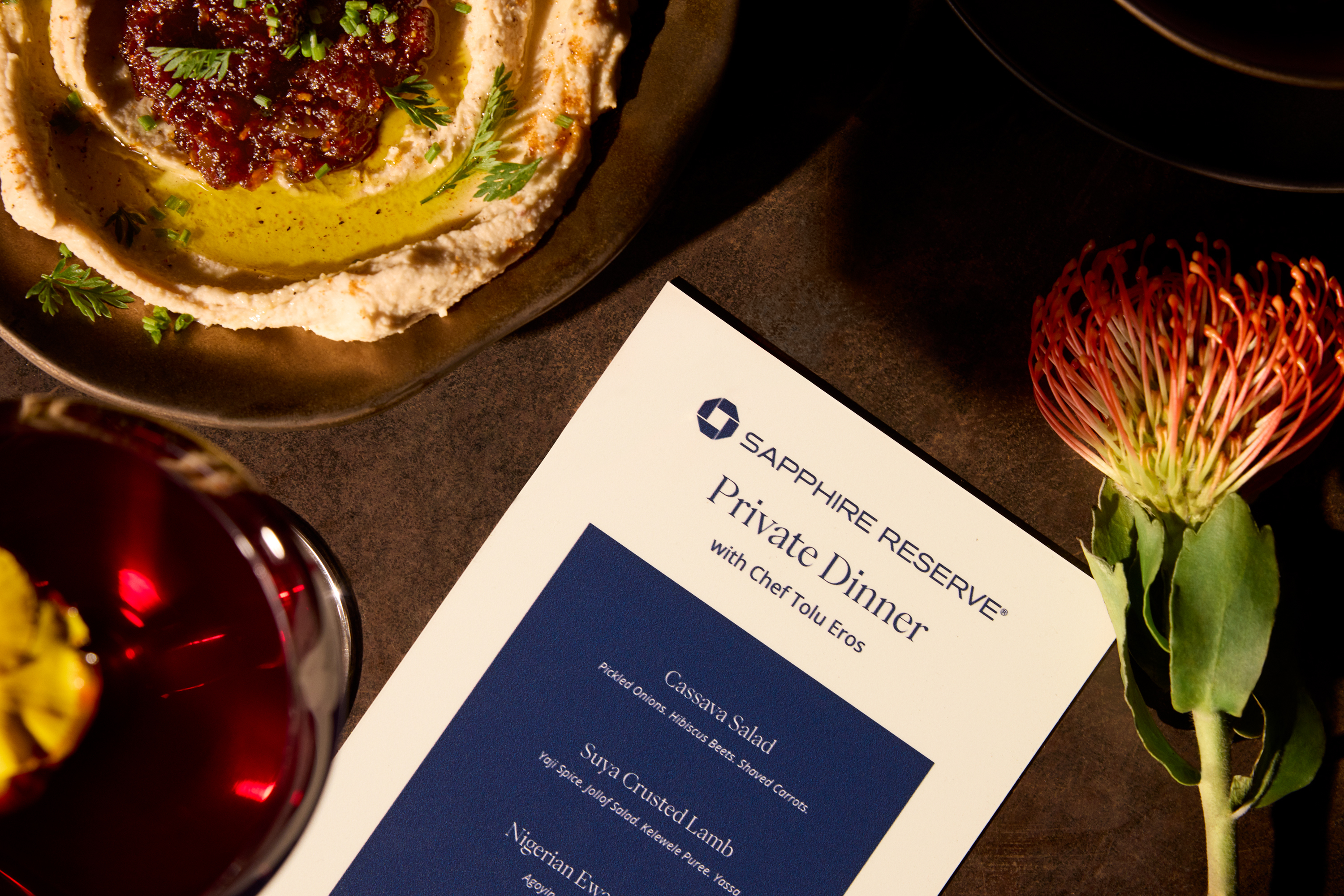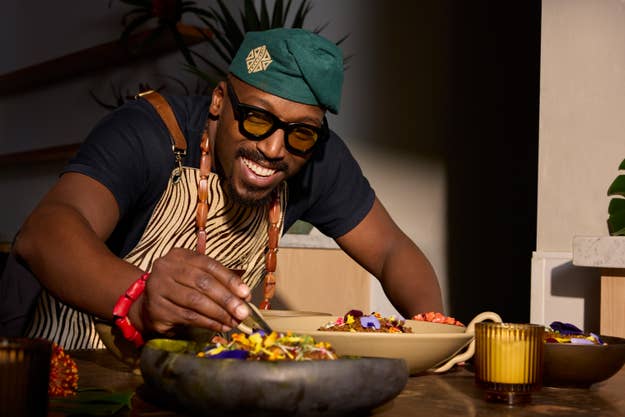
Chef Tolu “Eros” Erogbogbo is on a mission. Through his cooking, he works to bring people together and to put Nigerian and West-African cuisine on the global culinary map. To those ends, Eros operates ILÉ, a private dining room in Los Angeles, as well as ILÉ EROS, a restaurant in Lagos, Nigeria, along with a bakery and catering operation in the latter city.
He also stars in the new Chase Sapphire “Taste of West Africa” spot with Michael B. Jordan and other luminaries, including ESPN Analyst and WNBA player Chiney Ogwumike, one-time NBA player Pops Mensah Bonsu, musician and producer Sarz, actor and DJ Tony Okungbowa, and actor Michael Oloyede. Academy Award-nominated cinematographer and director Bradford Young directed the film.
The 60-second film dropped earlier today. Embedded here, and also available on Jordan’s Instagram, it shows Eros presiding over an intimate dinner where guests debate which West African country makes the best jollof rice, only for the chef to come up with a novel—and delicious—answer.
“This spot shows an unscripted conversation that gives both those familiar and those curious an authentic look at the ongoing debate on who makes the best jollof,” Stanley Lumax, Executive Director of Brand Marketing at Chase, says. “More significantly, it leaves room for unity, which is the important takeaway beyond all the debate.”
With the “Taste of West Africa” campaign in mind, Complex recently sat down with Eros to talk culture, cooking, and, of course, jollof.
Everyone should know what jollof is, but for those who don't, can you just break it down please?
Jollof rice is West Africa's prized possession. It's the most popular dish in all of West Africa. It's one dish that every single West African country makes. It's a tomato-based, pepper-based, spice-based rice dish that has been made across all of West Africa. It originated in the 1800s with the Wolof people of Senegal and has become a West African sensation. It's a labor of love. It takes a lot of time to make. It's one of those dishes that is typically celebratory. You would make it if you were having a party. You’ve got to have jollof rice. People say that there's no party without jollof rice. My grandmother would always say that if you don't cook with love, do not cook at all. So if you are not cooking jollof rice with love, don't bother.
The base flavors are peppers, tomatoes, onions, and spices of curry, thyme, and bay leaf. Every single West African country makes theirs differently. And I'm sure you've heard about the jollof wars, right? Different West African countries are fighting about who makes the best jollof. The loudest ones are the Nigerians and the Ghanaians, and now the Senegalese. The Senegalese are like, Yo, we created jollof rice, so really and truly you are all fighting for second place.
I love how that all shows up in the new Chase Sapphire spot.
Yes, but you know we're here to solve the West African table wars, right? We're here to solve that problem.

Totally. Before we get to that though, can you please explain the differences between Senegalese, Nigerian, and Ghanaian jollof?
Yes. So in Ghanaian jollof, the rice is perfumed. But every single person and every single tribe makes jollof slightly differently. The single most important difference between Ghanaian jollof rice and all the others is the use of the perfumed rice, using either jasmine or basmati rice. Some Ghanaians will put nutmeg in their jollof. I think that's crazy [laughs]. But do whatever you want [laughs].
The Senegalese are known for eating together off one big plate. And so they would use all of the resources that they have to make their jollof rice. Senegalese jollof rice is really rich with a lot of vegetables. So you would see aubergines and carrots. You'd see plantains, and in some cases, a lot of seafood as well. The key is really the additional things that are put into the jollof rice for the Senegalese. It’s really about those different elements that are put on top of the jollof rice to make it rich.
The Nigerians are the party people. So our jollof rice is known as the “party jollof.” That's when we come out to make jollof rice. We use this pot called the adogan. It's a silver pot and we cook it over firewood and the firewood infuses smoke flavor into the jollof. Now the jollof also burns at the bottom. The myth is that the bottom of the rice is where all the flavors and spices are and so we would typically add a little bit of that burned part into the rice, which makes the rice a little crunchy with smoky elements.
Now we fuse all of those three together by bringing in the perfumed rice from the Ghanaian. In our case, we use basmati. Then the vegetables from the Senegalese. In our case, we use vegetable stock and plantains added to the rice. And then the smokiness and the burnt bits from the Nigerians by letting that pot burn a little bit at the bottom and infusing the smoke into the rice and then scraping little bits of that bottom into the rice to give it a nice crunch.

Thank you so much. So that brings me to my next question. You’re describing the Unity Jollof you make, right? In the Chase film everyone is debating which country makes the best jollof. And then you solve that debate in a really cool way by making Unity Jollof. Was that your own concept? How did you come up with Unity Jollof?
It really is. And it's because I was always hosting dinner parties and every time I would host a dinner party, if I didn't put jollof on the menu, there’d be a problem. People would be like, I'm not coming to dinner. There's no jollof. So there had to be jollof. Now you put jollof on the dining table and the first thing people are going to ask is, Which jollof is this? Is this Nigerian jollof? Is this Ghanaian jollof? And so people are fighting about whose jollof it is without actually appreciating the jollof and enjoying themselves. And so, I created the unity jollof rice to end that debate.
You cannot argue about whose jollof is the best at my dining table. My ethos is that as people, we are stronger together as one than when we are separated. And that's why I say, One people, one jollof. So when I bring the Unity Jollof to the dining table, everyone is unified. There's no argument because everyone is present in that jollof. Everyone matters in that jollof. And it actually ended up becoming the best tasting jollof. We took the strength of the West Africans and combined it into one jollof.
That's an amazing explanation. I love that moment there in the video when you say, One people, one jollof. And as a chef, you know best that food has that power to bring all sorts of people together. Is that one of the main philosophies driving your work and your cooking?
Absolutely. The main reason why I do what I do is to bring people together, is to connect communities and to educate people about different cultures. I've spent time studying other cultures and now I want people to learn about my culture. And so, I'm using food as a medium of communication to bring people together around the dining table, to learn about a culture, to discuss, to talk, to share, and to engage and gradually grow into being a unified people.
Well said. And then of course, you have a restaurant in Lagos and one in Los Angeles, right?
So we have the restaurants in Lagos and we have a restaurant/private dining room in Hollywood.

Do you serve the Unity Jollof in either of those establishments?
Yes. So in the Los Angeles one, we serve the Unity Jollof rice as part of our seven course dining experience. It's the main course. In our restaurant in Lagos, we have five or six different types of jollof rice. The Unity Jollof Rice is one, but we also have a truffle jollof rice, we have a lobster jollof rice, we have a jollof pilaf, and we have the Nigerian classic jollof rice as well. And then we also have different specials. So sometimes we do the Ghanaian jollof rice. But now we're focused on the Unity Jollof Rice. So yes, the Unity Jollof is available at both locations.
What a cool signature dish for you and for your diners. Then pivoting back to the Chase Sapphire “Taste of West Africa” spot, there's so much talent in this short film. You have Chiney Ogwumike. You have Michael B. Jordan. And I know it was directed by Bradford Young. So you're obviously a superstar chef, but what's it like to work with these other huge talents from different industries?
I mean, amazing. For example, someone like Michael B. Jordan, who I've watched perform in different movies and especially after Black Panther, that's when I really started to appreciate him from an African standpoint. So seeing him in those huge films, you might not know what to expect meeting him, but he was so cool and so down to earth. I love real people. And it was the same with all the others who were at the dining table. They're all genuine, real people who care about others, who care about culture. And to bring all of them together at a dining table to have such an impactful conversation about culture, about the “Taste of West Africa,” is really a dream come true for me. I couldn't be more proud to be a part of this production and to work with amazing people like Bradford and the team at Chase to bring this project to life. It’s really and truly been a dream come true.
It shows in the film spot. Everyone is down to earth and the conversation about jollof is so natural. It seems like a group of friends getting together and chopping it up. Then, working with Chase Sapphire Reserve, the tagline at the end of the spot is, “Immersive dinners with world-class chefs.” Obviously, you're a world-class chef and the dinners you serve at your restaurants seem to be personal. How does that line up with Chase Sapphire Reserve?
My dinners are intimate. They're really about intentionally bringing together a community and Chase Sapphire Reserve is a platform that allows you to embark on different experiences, one of which is immersive dinners. So as a Chase Sapphire Reserve member, you’re able to access those dinners with world-class chefs who can create memorable experiences like the “Taste of West Africa.”
We all work hard every day and then you're able to pick up this card and use it to enjoy different experiences aside from just dining. There's also travel and other forms of entertainment. So really and truly, Chase Sapphire Reserve allows you to experience different forms of dining and entertainment around the world.
This interview was edited for clarity and concision.



